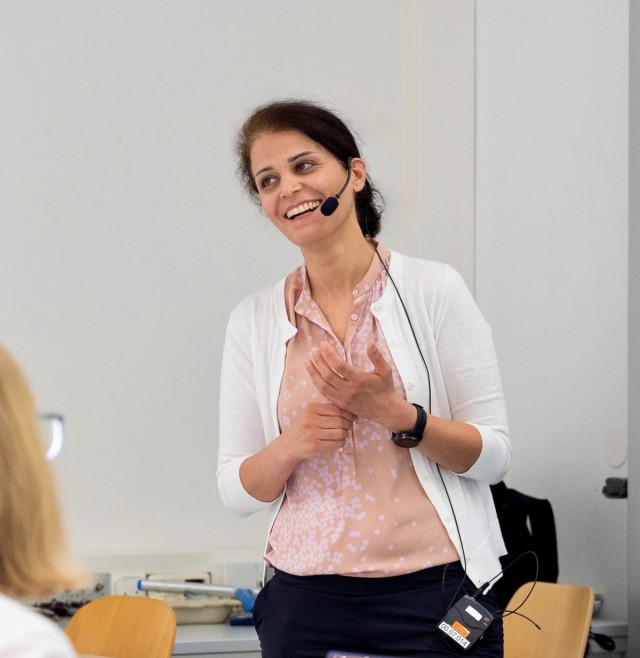Layla Hormozi of the Brookhaven National Laboratory gave a talk at MCQST in August 2022 as part of its Women in QST Series. We sat down with her to discuss her work, indirect career paths, and the exciting potential of topological quantum computing.
Layla Hormozi: Finding Her Own Way
How much can you still remember from your grade school science class? Layla Hormozi can still clearly picture the very page in her third-grade textbook that introduced her to the scientific method. The page told a simple story of a child who was able to form a conclusion about the world by applying the principles of the scientific method to his own life. This story helped usher Layla down a path of curiosity that has led her to where she is today: leading the quantum computing group at Brookhaven National Laboratory in New York. Although that path wasn’t always a straight line, the constant in her career has been the pursuit of knowledge and undying curiosity: “I feel like everything is interesting,” she says, “if you have the time to look into it deeply.”
This also drives her approach to quantum computing, a fast-developing field that has exploded in public interest in the last few years. There is much excitement in the media about the future applications of quantum computing, which some speculate will have major impacts on technology, society, and even politics. But Layla is interested in quantum computing purely from a scientist’s point of view. To her, the important question is: “In the process of building one, will I learn more about the underlying physics?”
Quantum computers are powerful machines that can solve certain kinds of problems that would be impossible for classical computers. The computers we use every day store information in “bits” represented by 1 or 0. On the other hand, quantum computers exploit the strange nature of quantum mechanics to store data in “qubits,” represented by 1, 0, or both 1 and 0 simultaneously. However, one of the main challenges to developing quantum computers is that the data stored is very unstable and delicate – it can often be destroyed by minimal disturbances from the environment.
 © MCQST
© MCQST Another challenge facing quantum computing is scalability – many researchers can create a good, isolated qubit, but adding additional qubits becomes increasingly difficult in other quantum computing architectures. Layla says topological computers would, in principle, have another clear advantage here: “If we manage to create one qubit, then in theory creating more qubits shouldn’t be difficult.”
While other quantum computing architectures have been successfully built, topological quantum computers are still in the theoretical stage. “But not for lack of trying on the experimentalists’ side,” Layla adds. Scientists are currently investigating how information could be encoded into such a system. Once this has finally been observed, Layla is optimistic that the technology could move very fast from there: “We know what kind of arrangement we want, we know what kind of movement patterns we want, but the practical side of realizing and controlling these excitations is still in the making.”
An Indirect Path
Layla readily admits that she could not have predicted where she would be today: “I didn’t necessarily think I would end up in a national lab, or even being working on this type of quantum computing, but it was a combination of one thing leading to another thing, and I’m very happy with where I am now.” Growing up, she was always interested in science, and kept seeking better and deeper understandings of nature. She eventually settled on physics, because she felt it was the very deepest. Towards the end of her Bachelor’s program at the Sharif University of Technology, she attended a colloquium about quantum information, which immediately captured her imagination. “When you’re first exposed to quantum physics, it just sounds very weird,” she says. “It would be fascinating to reverse engineer it to build quantum computers.”
"I would just say to my younger self, ‘Be less anxious and enjoy it more.'"
Through a lucky coincidence, Layla was first introduced to the concept of topological quantum computing in 2004, which at the time was a very new idea. Layla, then a grad student at Florida State University, was able to “get in on the ground floor” of this exciting new idea, and later dedicated her PhD research to it. After a couple of postdoc positions at the National Institute of Standards and Technology, National University of Ireland, Massachusetts Institute of Technology, the Institute for Quantum Computing in Waterloo, Canada, and even a brief detour into data science, she landed at her current position at Brookhaven National Laboratory as a staff scientist and group leader, and has since been doing the work she’s always dreamed of. “I love to understand how nature works and just really enjoy every moment of it,” she says. “Not just the moments where I succeed in solving a problem – every night I look forward to waking up and continuing my calculations.”
Enjoying the Moment
Layla was in Munich last month visiting the group of MCQST Member Robert König (TUM Department of Mathematics). During her stay she gave a talk introducing the concept of topological quantum compiling for a scientific audience. This talk was part of MCQST’s Women in QST series, and was followed by an informal networking session for female researchers within the research cluster. When talking with the early-career scientists in attendance, Layla was open about her experiences and encouraging about the future. Although, she admits, she has the benefit of hindsight, her go-to advice is to not stress too much about the future: “When I was younger, I was a lot more anxious about what comes next – what the next step or job might be. I would just say to my younger self, ‘Be less anxious and enjoy it more.’”